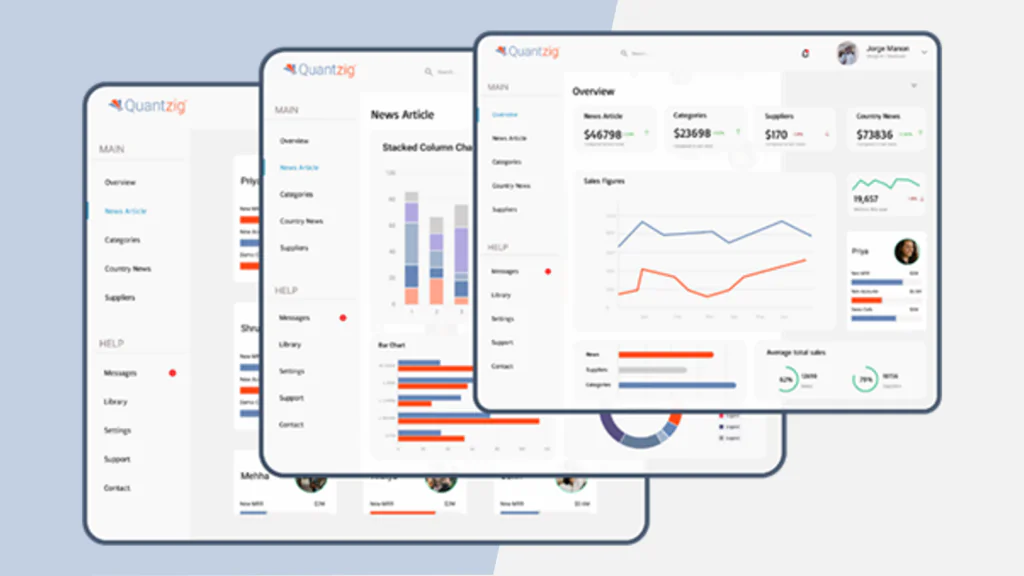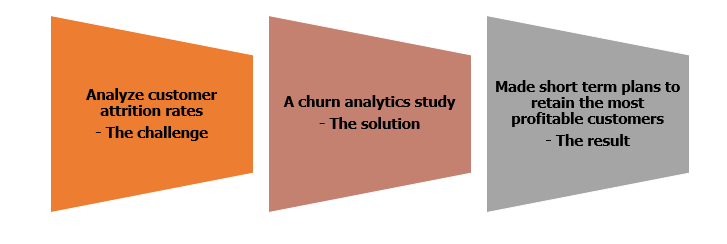In the dynamic landscape of healthcare, maintaining patient retention is critical for the long-term success and sustainability of healthcare providers. Healthcare churn analytics emerges as a strategic approach to understanding and mitigating patient attrition. By leveraging advanced data analytics techniques, predictive modeling, and machine learning algorithms, healthcare organizations can uncover valuable insights into the factors influencing patient churn. This proactive approach enables providers to identify at-risk patients, address root causes of churn, and implement tailored retention strategies. In this churn analysis case study, you’ll get in-depth knowledge on how healthcare churn analytics plays a pivotal role in enhancing patient satisfaction, optimizing resource allocation, and ultimately improving the financial performance of healthcare institutions.
Table of Contents
What You’ll Find in this Churn Analysis Case Study:
- About the Client
- Area of Engagement
- Industry Overview
- Healthcare Churn Analytics Business Challenge
- Healthcare Churn Analytics Solution and the Business Impact
- Healthcare Churn Analytics Solution Predictive Analytics
The Client: Retail healthcare provider
Area of Engagement: Churn analytics
Industry Overview
Very few things are potentially as disruptive as retail healthcare and retail clinics across the global healthcare sector. The global retail healthcare industry typically includes government healthcare facilities, hospitals, and pharmaceutical equipment manufacturers. Several prominent healthcare sector companies have started expanding critical care offerings while progressively partnering with national retailers and pharmacies to establish best-in-class walk-in retail healthcare outlets.
Moreover, several factors are influencing the growth of this sector across the globe, some of which include:
Value for money: Well-organized retail healthcare outlets deal with high volumes of drugs and medical services at a reasonable price; thereby, attracting customers on a large scale. This trend is expected to create an excellent opportunity for retailers to achieve more profits and allow new sub-groups to enter the market.
Book a demo to experience the meaningful insights we derive from data through our analytical tools and platform capabilities. Schedule a demo today!
Request a free demoImpact of technology: Today, the on-going rapid technological advancements have made it easier for establishments in the retail healthcare segment to handle large-scale businesses while efficiently catering to the needs of consumers. Furthermore, online marketing platforms are driving this sector toward a future with high growth prospects.
Many such factors are compelling retail healthcare firms to leverage the use of churn analytics solutions. These solutions offer real-time information to the industries in terms of the size of customer groups and their attrition prospects. These solutions help firms analyze customer behavior tendencies to determine the point at where the customer churns.
Why Do Customers Churn and How to Stop Them from Leaving?
- Comprehensive Churn Analysis with Data Analytics: Healthcare providers can leverage advanced data analytics techniques to conduct thorough churn analysis. By analyzing customer interactions, transaction history, patient satisfaction scores, and sentiment analysis, healthcare organizations can identify root causes of churn. Understanding the underlying patterns and factors contributing to customer churn is crucial in devising effective retention strategies. Data preprocessing and predictive modeling enable the identification of at-risk customers and the prediction of potential churn events. By proactively addressing issues identified through data analysis, healthcare providers can intervene before customers decide to switch providers.
- Enhanced Customer Engagement and Satisfaction: Implementing personalized offers, tailored subscription plans, and flexible payment options can significantly improve customer satisfaction and engagement. By leveraging machine learning algorithms and predictive analytics, healthcare providers can segment their customer base and deliver targeted marketing efforts. Moreover, focusing on enhancing user experience through technological advancements in software development and electronic health records (EHRs) ensures seamless patient engagement. By prioritizing patient satisfaction and actively seeking feedback, healthcare organizations can continuously adapt and improve their services to meet evolving digital expectations.
- Proactive Customer Relationship Management: Adopting a proactive approach to customer relationship management is essential in preventing churn. Automated alert systems can notify healthcare providers of potential churn indicators, such as missed appointments or declining satisfaction scores. By promptly addressing issues and concerns raised by customers, healthcare organizations demonstrate their commitment to customer care. Building strong customer relationships based on trust and transparency fosters loyalty and reduces the likelihood of customers seeking alternative providers.
- Strategic Market Expansion and Competitive Pricing: To mitigate churn and maintain a competitive advantage, healthcare providers must strategically expand their market presence. Analyzing geographic locations and population health data enables targeted expansion efforts aimed at addressing unmet needs and preferences of specific demographics. Offering competitive pricing and differentiated product features further strengthens the value proposition for customers. By continuously monitoring market dynamics and adapting pricing strategies accordingly, healthcare organizations can remain competitive and retain their customer base.
- Continuous Improvement through Customer Feedback and Monitoring: Implementing robust customer churn monitoring systems allows healthcare providers to track the effectiveness of retention strategies over time. By measuring churn rate and analyzing churn patterns, organizations can identify areas for improvement and refine their prevention techniques. Utilizing customer churn prediction models and analytics tools empowers healthcare providers to anticipate and address potential churn factors proactively. Regularly soliciting feedback from customers and conducting sentiment analysis ensures that the organization remains responsive to evolving customer needs and preferences. By prioritizing customer satisfaction and loyalty, healthcare providers can effectively reduce churn and sustain long-term growth.
What Is Churn Analysis and what are its benefits?
This is a crucial process for healthcare providers aimed at understanding and mitigating customer attrition. It involves the systematic examination of customer behaviors, interactions, and patterns to identify reasons why customers discontinue their relationship with the healthcare organization. By leveraging data analytics techniques such as predictive modeling, machine learning algorithms, and sentiment analysis, healthcare providers can gain insights into the root causes of churn and develop effective strategies for retention.
Benefits of Churn Analysis:
- Insight into Customer Satisfaction: This technique allows healthcare providers to assess customer satisfaction levels by analyzing patient feedback, appointment scheduling data, and sentiment analysis. Understanding the factors influencing patient satisfaction enables organizations to address issues promptly and enhance overall service quality.
- Competitive Advantage: By conducting churn analysis, healthcare providers can gain a competitive advantage by identifying areas where they are losing customers to competitors. Analyzing market dynamics, product features, and competitive pricing helps organizations differentiate their offerings and retain customers effectively.
- Proactive Customer Retention Strategies: This tool empowers healthcare providers to develop proactive customer retention strategies based on predictive analytics and customer churn prediction models. By identifying at-risk customers and implementing personalized offers and subscription plans, organizations can minimize churn and maximize customer lifetime value.
- Optimized Resource Allocation: By understanding customer segments and geographic locations prone to higher churn rates, healthcare providers can allocate resources more efficiently. Market expansion efforts can be targeted towards areas with untapped potential, while customer retention efforts can be prioritized in high-churn regions.
- Improved Patient Engagement and Experience: This technique helps healthcare providers enhance patient engagement and user experience by identifying areas for improvement in appointment scheduling, electronic health records (EHRs), and population health management. By addressing root causes of churn such as poor user experience or lack of personalized communication, organizations can foster stronger patient relationships and loyalty.
In summary, churn analysis enables healthcare providers to gain valuable insights into customer behaviors and preferences, leading to improved customer satisfaction, competitive advantage, and optimized resource allocation. By leveraging data analytics and predictive modeling techniques, organizations can develop proactive retention strategies and enhance patient engagement, ultimately driving long-term growth and success.
Want to know more about the benefits of churn analytics for the retail healthcare industry? Experience the advantages firsthand by testing a customized complimentary pilot designed to address your specific requirements. Pilot studies are non-committal in nature.
Request a free pilotWhat are the effective Churn analytics tools?
- IBM Watson Studio: IBM Watson Studio is a comprehensive data analytics platform that offers advanced tools for churn analysis in healthcare. Leveraging predictive analytics and machine learning algorithms, Watson Studio enables healthcare providers to uncover insights from diverse data sources such as electronic health records (EHRs), transaction history, and patient satisfaction surveys. With built-in capabilities for data preprocessing and predictive modeling, organizations can identify root causes of churn and develop proactive retention strategies. Watson Studio also offers automated alert systems and customizable dashboards for monitoring customer churn rates and impact, empowering healthcare providers to take timely action to prevent customer attrition. Furthermore, its integration with IBM’s ecosystem of healthcare solutions ensures seamless deployment and scalability for organizations seeking to enhance customer relationships and drive long-term growth.
- Salesforce Einstein Analytics: Salesforce Einstein Analytics is a powerful AI-driven platform that provides healthcare providers with tools for churn analysis and customer relationship management. By integrating data from various sources including customer interactions, appointment scheduling, and sentiment analysis, Einstein Analytics enables organizations to gain actionable insights into customer churn patterns and factors. Its predictive modeling capabilities allow healthcare providers to forecast churn events and prioritize retention efforts effectively. Additionally, Einstein Analytics offers personalized recommendations and automated workflows for implementing customer retention strategies such as personalized offers and subscription plans. With its user-friendly interface and customizable features, Salesforce Einstein Analytics empowers healthcare organizations to optimize customer relationships and drive competitive advantage in the digital age.
- Google Cloud AI Platform: Google Cloud AI Platform offers a suite of tools for churn analysis and predictive modeling tailored to the needs of healthcare providers. With its scalable infrastructure and advanced machine learning algorithms, organizations can analyze large volumes of data including patient demographics, geographic locations, and population health trends. Google Cloud AI Platform provides pre-built models and APIs for sentiment analysis, customer segmentation, and churn prediction, enabling healthcare providers to derive actionable insights quickly. Its integration with Google Cloud’s ecosystem of services such as BigQuery and Dataflow ensures seamless data processing and analysis workflows. Moreover, Google Cloud AI Platform offers comprehensive documentation and support resources for organizations embarking on their churn analytics journey, making it an effective tool for driving customer retention and satisfaction.
- Microsoft Azure Machine Learning: Microsoft Azure Machine Learning is a cloud-based platform that empowers healthcare providers to build, deploy, and manage machine learning models for churn analysis and customer relationship management. With its intuitive interface and drag-and-drop tools, Azure Machine Learning enables organizations to preprocess data, train predictive models, and evaluate model performance with ease. Leveraging Azure’s vast array of data sources including electronic health records (EHRs), transaction history, and patient feedback, healthcare providers can gain insights into customer churn patterns and factors influencing attrition. Azure Machine Learning offers built-in algorithms for predictive modeling and customer segmentation, as well as support for custom model development using Python and R. Its integration with Microsoft’s ecosystem of healthcare solutions such as Dynamics 365 and Power BI ensures seamless data integration and actionable insights for driving customer retention strategies.
- Tableau CRM (formerly Einstein Analytics): Tableau CRM, formerly known as Einstein Analytics, is a leading business intelligence platform that provides healthcare providers with tools for churn analysis and customer retention. With its intuitive data visualization capabilities and predictive analytics features, Tableau CRM enables organizations to uncover hidden patterns and trends in customer data. By integrating data from electronic health records (EHRs), patient satisfaction surveys, and transaction history, healthcare providers can gain insights into root causes of churn and identify at-risk customers. Tableau CRM offers pre-built dashboards and templates for churn analysis, as well as customizable workflows for implementing retention strategies such as personalized offers and targeted marketing campaigns. Its seamless integration with Salesforce’s ecosystem of healthcare solutions ensures data consistency and scalability for organizations seeking to enhance customer relationships and drive business growth.
What Are Possible Strategies and Practices to Reduce Customer Churn?
- Data-Driven Churn Analysis: Effective churn reduction strategies begin with comprehensive churn analysis utilizing data analytics techniques. Healthcare providers can leverage predictive analytics and machine learning algorithms to identify root causes of churn, such as poor customer satisfaction, suboptimal user experience, or unmet patient expectations. By analyzing customer interactions, transaction history, and sentiment analysis, organizations can gain valuable insights into churn patterns and factors influencing attrition. Data preprocessing and predictive modeling enable the identification of at-risk customers and the prediction of potential churn events, empowering healthcare providers to take proactive measures to retain customers.
- Proactive Customer Relationship Management (CRM): Building and maintaining strong customer relationships is essential in reducing churn. Implementing a proactive customer relationship management (CRM) strategy involves regular communication, personalized engagement, and attentive customer service. Automated alert systems can notify healthcare providers of potential churn indicators, such as missed appointments or declining satisfaction scores, allowing organizations to intervene promptly. By prioritizing customer satisfaction and actively seeking feedback, healthcare providers demonstrate their commitment to customer care, fostering loyalty and reducing the likelihood of customers seeking alternative providers.
- Tailored Retention Strategies: Effective retention strategies are tailored to meet the specific needs and preferences of individual customers. By segmenting customers based on factors such as geographic location, demographics, and transaction history, healthcare providers can deliver personalized offers, subscription plans, and marketing efforts. Offering flexible payment options and competitive pricing further strengthens the value proposition for customers, increasing their loyalty and likelihood of remaining with the organization. Moreover, proactive outreach initiatives, such as appointment reminders and follow-up communications, demonstrate proactive engagement and enhance overall customer satisfaction.
- Continuous Improvement and Innovation: To remain competitive and reduce churn, healthcare providers must prioritize continuous improvement and innovation. Investing in software development and technological advancements, such as electronic health records (EHRs) and appointment scheduling systems, enhances user experience and patient engagement. Analyzing market trends and digital expectations enables organizations to anticipate evolving customer needs and preferences, ensuring that their offerings remain relevant and compelling. Moreover, soliciting feedback from customers and conducting sentiment analysis allows healthcare providers to identify areas for improvement and refine their services, accordingly, driving long-term customer satisfaction and loyalty.
- Strategic Market Expansion and Differentiation: Expanding market presence strategically and differentiating offerings effectively are key strategies in reducing churn. Analyzing market expansion opportunities based on geographic location and population health management data enables healthcare providers to identify underserved areas and unmet needs. By offering unique product features, competitive pricing, and flexible payment options, organizations can differentiate themselves from competitors and attract and retain customers. Moreover, focusing on patient engagement initiatives, such as personalized healthcare plans and proactive health management, strengthens customer relationships and reduces the likelihood of churn. Overall, strategic market expansion and differentiation enable healthcare providers to maintain a competitive advantage and drive sustained growth while minimizing customer attrition.
Healthcare Churn Analytics Business Challenge
The client, a prominent retail healthcare provider with business operations spread across the globe, wanted to evaluate the customer acquisition rates and accordingly devise effective strategies to retain the most profitable customers. With the help of churn analytics, the client also wanted to develop a machine learning model to examine customer acquisition costs and undertake short-term actions to reduce churn rates.
After attending one of our webinars on churn analytics, the healthcare client decided to contact our experts for a free demo.
Churn Analytics Solution and the Business Impact
Strategies we recommended based on our analysis to reduce attrition levels and retain the most profitable customers
With the help of Quantzig’s churn analytics, the retail healthcare provider was able to quantify the feedback from customers and address their queries to boost customer interaction and loyalty. This tool also helped the client effectively segment customers based on their behaviors and revamp their marketing campaigns to decrease the probability of churn.
Churn Analytics Solution Predictive Analytics
The churn analytics engagement offered by Quantzig helped the retail healthcare provider develop custom features for customers who are more likely to churn. The engagement also provided real-time information on ways to determine the likeliness of clients abandoning their services.
Get started with your complimentary trial today and delve into our platform without any obligations. Explore our wide range of customized, consumption driven analytical solutions services built across the analytical maturity levels.
Start your free trial todayHow Churn Reduction May Boost Your Revenue?
Reducing customer churn is not only vital for maintaining a stable customer base but also for driving revenue growth in healthcare organizations. By implementing effective churn reduction strategies, healthcare providers can enhance customer satisfaction, improve customer relationships, and ultimately increase revenue streams.
- Increased Customer Satisfaction and Engagement: Reducing churn directly correlates with increased customer satisfaction and engagement. By addressing root causes of churn such as poor patient satisfaction, suboptimal user experience, or ineffective customer interactions, healthcare providers can improve overall customer satisfaction levels. Satisfied customers are more likely to engage with the organization, utilize additional services, and recommend the provider to others, leading to higher retention rates and increased revenue opportunities.
- Enhanced Customer Relationships and Loyalty: Implementing proactive customer relationship management practices fosters stronger customer relationships and builds loyalty. By demonstrating attentiveness, responsiveness, and personalized care, healthcare providers can cultivate trust and loyalty among their customer base. Loyal customers are less likely to switch providers and more inclined to continue utilizing the organization’s services over time, resulting in sustained revenue streams and reduced customer churn.
- Optimized Revenue Streams from Retained Customers: Reducing churn results in optimized revenue streams from retained customers. By retaining existing customers, healthcare providers can minimize the need for costly acquisition efforts to replace lost customers. Retained customers tend to exhibit higher lifetime value, as they continue to generate revenue through repeat purchases, ongoing subscriptions, and additional services. Moreover, satisfied and loyal customers are more receptive to upselling and cross-selling opportunities, further increasing revenue potential for the organization.
- Strategic Market Expansion and Differentiation: Churn reduction enables healthcare providers to focus resources on strategic market expansion and differentiation initiatives. By analyzing market trends, geographic locations, and population health management data, organizations can identify growth opportunities and tailor their offerings to meet the unique needs of target demographics. Differentiated products, competitive pricing, and flexible payment options attract new customers while retaining existing ones, driving revenue growth and minimizing churn.
In conclusion, reducing churn is essential for boosting revenue and driving sustainable growth in healthcare organizations. By prioritizing customer satisfaction, engagement, and retention through effective churn reduction strategies, healthcare providers can optimize revenue streams from retained customers, enhance customer relationships, and capitalize on market expansion opportunities. Moreover, by leveraging data analytics, predictive modeling, and proactive customer relationship management practices, organizations can identify and address root causes of churn, ensuring long-term profitability and success in an increasingly competitive healthcare landscape. Ultimately, investing in churn reduction not only improves financial performance but also strengthens the organization’s reputation and position in the market, driving sustained revenue growth and business success.




